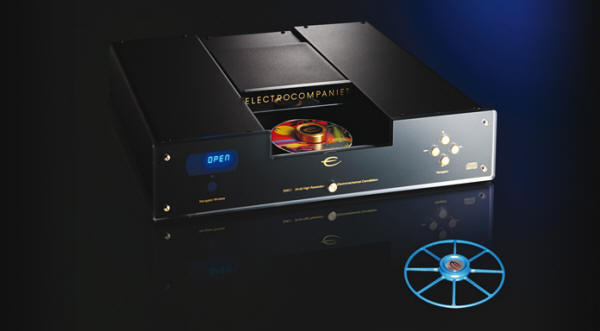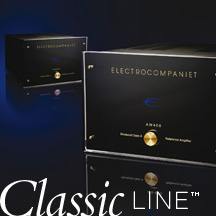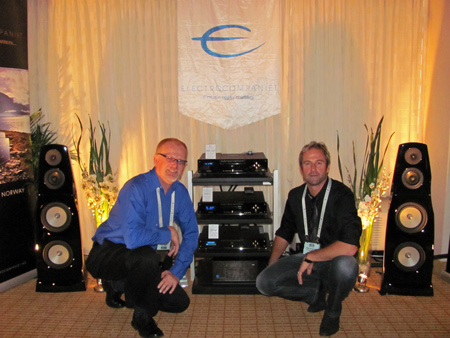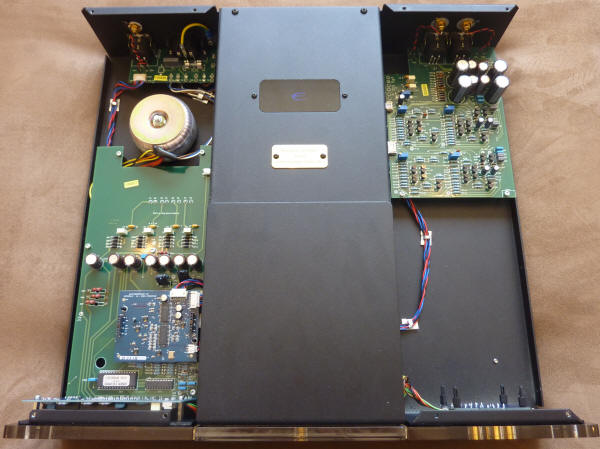|
You are reading the older HTML site
Positive Feedback ISSUE 51
Electrocompaniet EMC-1UP - Revisited
Revisit… what? Okay…, this may not be a first for Positive-Feedback magazine, but it is definitely a first for me. Last January, Issue 47 I wrote a review evaluating the Electrocompaniet EMC-1UP CD player. Since that time I have gathered some new insight into this very unique and ground breaking CD player. What has transpired since last January that prompted this change of heart? Namely, I am now hearing the EMC-1UP in a much different light—one that truly allows the EMC-1UP to shine better than it ever did in the past. As stated in my article last January, I really liked the EMC-1UP. However, I am now enjoying it at a level I never thought was possible when listening to digital. This is due to some upgrades to my reference system, and one minor change regarding EMC-1UP itself, more on that later. The changes made to my system are as follows: A new reference preamplifier—the Audio Horizons 2.2RcvB, and a re-cabling of the entire system with the more musical Audience Au24-e cables. This change includes all of my RCA and XLR interconnects, along with my bi-wire speaker cables. I also replaced my old A/C power cords with Audience 15amp IEC powerChord-e cables. In addition, I swapped out my Audience aR6 line conditioner for the top-of-the-line Audience aR6t (Teflon) line conditioner. Last, I replaced the cheap OEM tin based power fuses inside my gear with SilverStar HiFi tuning fuses. In that mix, the EMC-1UP also received a new SilverStar HIFI-Tuning fuse. My God…, these above improvements made a huge difference in the overall signature as to how my reference system is now performing. With this new found insight into the voicing of my reference system, the EMC-1UP reminds me of a thoroughbred horse waiting to get out of the gates before a race, it just wants go. In the case of the EMC-1UP within my reference system, this virtual gate was caused by the limitations of the gear, my cables and those pesky tin based fuses. I know this may seem like the "no duh" hypothesis. I really thought my system sounded great before the changes. However, I was truly surprised how these changes made such global impact upon the overall sonic signature of my reference system. Most importantly, these changes really made a difference as to how my EMC-1 performs. Now I am experiencing the EMC-1UP under an entirely different light. Before the EMC-1UP was a great player, now it has become a true reference instrument. With that in mind I felt compelled to revisit and update my entire review from January, 2010. Electrocompaniet EMC-1 UP Revisited As I stated last January, I was first introduced to the EMC-1UP 24/192 compact disc player at the 2001 Consumer Electronics Show. During the show, I noticed something unusual. Many of the vendors were displaying Electrocompaniet EMC-1 UP as their main source right along side the products they were promoting. I found this strange as the EMC-1UP kept coming up as the CDP of choice from soundroom to soundroom. Knowing the vast availability of quality digital sources to choose from within the great big sea of high end audio you would think other players would be displayed. They were. However, it was the EMC-1UP that I saw time and time again coming up as the CDP of choice. Let's not forget in 2001 SACD was beginning to establish itself within the digital market along with the DSD based Sony CD-1 SACD player leading the pack—a player that was earning rave reviews at the time. CES 2001 was a special time, or at least it was for digital players with the EMC-1UP leading the pack. Fast forward nine years later, and once again we are looking at the EMC-1UP. Okay, okay, I know what many of you readers are thinking, and to some degree I feel the same way too. Why write a review discussing a product that is almost ten years old? To that I say, why not? The EMC-1UP is still a part of Electrocompaniet's Classic line and it has yet to be discontinued. Although it may seem the EMC-1 is getting long in the tooth it can still run with the big boys of the digital world. What is truly remarkable during the last nine years for the most part the EMC-1UP has remained unchanged—other than a few parts added or replaced to tweak the unit a bit here and there. Will the EMC-1UP become a classic like the venerable Linn LP-12? Only time will tell.
Before we move forward with this review, I feel it is necessary to come clean about something you need to know. As I stated last January, this review is a bit unique in that I would like to call it the backwards or dyslexic review. I had owned the Electrocompaniet EMC-1UP prior to the review being published. With that said, I felt a bit odd writing a review about a product I already own. Usually a review is written first, then at the end of the review period if the reviewer is interested in purchasing the product as a courtesy the product is offered to the reviewer at a discount. When I approached Dave Clark last October I informed him that even though I own the EMC-1UP it is so good it had to be reviewed. Dave approved, and the review was on. From that point I contacted Electrocompaniet and received their permission to move forward with the review. One more thing I want to add before discussing my review of the EMC-1UP. I was never solicited by Electrocompaniet to review the EMC-1UP. Not that there is anything wrong with being solicited for a review, it happens all the time. The point is I believe in this product so much that I felt compelled to tell its story. After moving into our new home during February of 2006 I was looking to replace my then reference Mark Levinson Model 37 transport and Dodson 218 DAC to a one box solution. The cause for this change was I wanted to downsize my rig into one rack. In 2006, like any other potential buyer, I looked at several players ranging in price from $2500 to almost $10,000. This list included SACD players, universal players, Redbook only CD players, and even CDPs with a tube output stage. I purchased two of these—a highly modified Sonic Frontiers SFCD-1 SE+ (modified by Chris Johnson at Parts Connexion) and an E.A.R. Acute. While both players were highly musical and damn nice in their own right, in the end, I kept coming back to the EMC-1 UP as the player of choice when it came down to listening to music for the long haul. This speaks volumes regarding the EMC-1UP.
Peder Beckman, courtesy of www.stereophile.com I have always had a fondness for Electrocompaniet products. Being a tube guy, Electrocompaniet products sound a lot like the best qualities of tube gear while still maintaining the speed, impact, dynamic headroom, and accuracy of solid state gear. Not bad in my opinion for a solid state product coming from the frozen tundra of Norway. You would think Electrocompaniet would be a tube based company knowing how cold it can get during those long Norwegian Winters. This tube like sound has a lot to do with Electrocompaniet's original design philosophy, their goal is to create products that lean toward the side of musicality or "getting the music right" as opposed to reaching for that last bit of extension many other manufacturers strive toward. This is paying high compliment to Electrocompaniet since most solid state products do not excite me or grab me emotionally like tube based gear does. What is truly amazing, all of the gear offered by Electrocompaniet is solid state in design—not tubes. In my opinion, that is truly a "hat trick" getting tube like musicality from a solid state design. Another aspect I like about the Electrocompaniet gear is, their looks. Since I am an aesthetics kind of person Electrocompaniet products display what I would like to call SES—Sexy European Simplicity. All of their Classic Line products share a similar face plate design that is simple, functional, classy, and good looking all at the same time.
"You know what the meaning of life is….? Stick to one thing." (City Slickers, 1991) Why hasn't Electrocompaniet replaced the EMC-1UP since its introduction in 2001, or offered a completely different model over the years? This is not to say Electrocompaniet has rested on their laurels. The addition of the 24/192 Delta Sigma DAC in 2001 made a huge difference in sound as compared to the 24/96 DAC it replaced. 2003 was the last time the EMC-1UP was updated with a new printed circuit board, along with some internal parts being swapped out or upgraded, ending up with a new Philips CD Pro II transport mechanism that is still in production today. Though a conservative approach, I believe Electrocompaniet is right on the mark. I believe the old saying of; "if it ain't broke, why fix it" applies. Often manufacturers change models in their line-ups in their quest for better sound, or maybe it is to generate new sales as old models are replaced with newer models. Since I have seen this happen often within the high end audio industry, I do believe to some degree that marketing decisions overwhelm the audiophile decisions when replacing a current product. I never got that feeling in with dealing with Electrocompaniet. Ponder that for a moment if you will. Maybe that is why the EMC-1 UP has remained for the most part unchanged in design since its introduction in 2001. Come to think of it many other Electrocompaniet products have remained within the line up for quite some time, for example, the AW-180 monoblocks. These stellar sounding Class A monoblocks have for the most part remained unchanged since their introduction to the product line. Introduced in 1999, the AW-180s are still going strong. To me this is proof again that Electrocompaniet clearly is on to something regarding their products. Let's not get confused here Electrocompaniet isn't the only company with a conservative approach when it comes to keeping certain models within a product line. There are plenty of examples that come to mind, for instance: E.A.R., Quad speakers, Linn Sondek LP-12 turntable, hell even my reference speakers from Aerial Acoustics have been around since 1995 with the only change being a "B" upgrade in 1998. Knowing the Aerial 7B speakers have been around for 12 years in the "B' version and the EMC-1UP for almost 10 years now maybe sticking to one thing really isn't so bad? Obsession is the name of the game. What sets the EMC-1UP apart from the multitude of CD players offered in high end audio? What is the secret to EMC-1UP's staying power over all of these years? To answer these questions we must start by taking a look at Electromagnet's central design philosophy or paradigm as it is applies to the EMC-1UP's transport system. This paradigm is reflected in how the EMC-1 UP earns the "EMC" in its name. EMC stands for Electrocompaniet-Mechanical-Cancellation system. The designers focus on the EMC-1UP's transport and how it is affected by several of types of mechanical interferences that impair performance. Most of us audiophiles know that a mistracking laser can induce jitter into the digital data stream. The Electrocompaniet design team believes that this is one of the central causes why digital sounds, well, like digital. A mechanical vibration to the transport causes the laser to mistrack translating to mechanical jitter. It is jitter which takes the life out of the music, it can sound hazy or brittle, or as Electrocompaniet states "it removes the soul and emotion out of the music." In the end, it is jitter or the lack thereof in the data stream that truly separates a state-of the-art CD player from one that merely spins CDs. To correct this problem of mechanical induced jitter, first and foremost Electrocompaniet looks at the internal mechanism of a CD player transport. To Electrocompaniet the transport is very similar to a platter of a turntable. Just like a stylus tracking the inner modulations within a record's groove, lasers are affected by vibration and resonance. For vinyl, we call this mistracking. In CD reproduction this mistracking of the laser introduces "jitter" or timing errors that can limit dynamics and smear imaging. This results in the central complaint most listeners have when discussing digital as compared to analog, it lacks the musical emotion that analog almost always gets right. I truly believe this is one of the main reasons why many of the CDPs I have listened to over the years, try as they might to sound like analog, still don't get it right. If you do not properly isolate the transport from external vibrations and noise, jitter or mechanical induced jitter will be introduced into the data signal. Not so when discussing the EMC-1UP. Electrocompaniet addresses this issue of external and internal noise vibration by first incorporating a 7KG steel-dampened mechanism built on carefully selected damping feet. Get this, the design team was so obsessed with the effects of resonance and external vibrations that cause a laser to mistrack that when developing the EMC-1 UP they went to the extreme of evaluating several rubber and silicone materials to be placed under the damping weight prior to finalizing the EMC-1UP for production. Further isolation from mechanical noise is provided by the use of Electrocompaniet's proprietary Floating Transformer Technology (FTT) where all transformers within the EMC-1UP are acoustically isolated from the circuit board and its related electronics. Transformers (though necessary to electronic design) are noisy vibrating mechanical devices that interfere with the sound of our precious electronics. Here noise and mechanical vibrations created by transformers are picked up by the internals of our gear as a signal. This signal interferes which a product's clarity which can result in poor inner detail and dynamic prowess resulting in sound that is sluggish and smeared. Not so with the EMC-1UP. It is this kind of obsession in isolating the Philips Pro CD Pro II transport, dampening it with a 7KG steel mechanism, and setting it on carefully selected damping feet that results in the EMC-1 UP having one of the lowest jitter specifications within its class. Couple that with all of the measures Electrocompaniet takes in order to eliminate other mechanical interferences within the circuit and what you have in the end is a CDP that produces music from the blackest of black backgrounds this reviewer has experienced!
In addition to the enormous effort Electrocompaniet took when developing the transport mechanism for the EMC-1UP, here are some other areas within the design worth noting.
I feel at this point it is worth noting especially since so many owners of the EMC-1 UP clearly encourage the use of its XLR outputs as compared to RCA. The EMC-1UP does offer the choice or either RCA or XLR outputs so why not play around and figure out which set sounds best. It is true there is a slight difference in upper end detail and speed when running only XLR output. However, my experience is, since the use of my current preamplifier (Audio Horizons 2.2RcvB) I have found I like the attributes of both when running a pure RCA or XLR based system. Though the difference is subtle, it is clearly noticeable. When running the EMC-1UP with its XLR outputs I do believe it has a slight edge over RCA outputs in the areas of high frequency presentation, bass response, and what seems to be a bit more inner detail and speed as compared RCA which is a ever so slightly rolled off at the top end. Is this because running XLR sounds better or is it a result of running the third leg in the connection which helps reduce Eddy currents in the signal that can smear sound, or is it the added 10dB in gain as compared to RCA? I believe all of these are factors affect the sound reproduction of the EMC-1UP when running it with its XLR outputs. On the other hand, when running EMC-1UP using its RCA outputs it does have a little added warmth that can be perceived as it being a bit smoother as compared to running it balanced. Meaning, if you own a system that runs on the lean side then running the EMC-1UP with its RCA output may be just your ticket. Please note: For the purposes of this review I really did bounce back and forth running RCA or XLR depending upon which amplifier I was using at the time. For the rest of you out there, I am sure your experience may vary due to the type of gear and the cables you use when connecting the EMC-1UP to your system. One last notation: All of my listening has been with the optional Spider Clamp—a $500 added accessory. It would take too long to discuss in detail the differences between the sound of the player when running with the Spider Clamp as opposed to running it with the stock clamp. However, it should be noted due to better stabilization to the CD while playing, I do recall improved bass performance where it tightened it up a bit, and with better overall resolution. All of these features are examples of Electrocompaniet' s obsession with "getting it right" the first time when building a product. So, maybe Jack Palance's character in the movie City Slickers was right when he stated "stick to one thing." Meaning, if you stick to one thing you will be great at it, or in the case of Electrocompaniet, sticking to one thing surely created a product that has stood the test of time—the EMC-1UP Enough already, what really matters is how it sounds To keep things consistent, I am using to the same CDs I used for evaluation of the EMC-1 UP in January for this updated review. For the most part the CDs I used for evaluation were from a three CD collection of Ben Harper's early work recorded in the mid to late nineties. For those of you unfamiliar with Ben Harper's music it is all over the place, influenced by a multitude of musical genres: Folk, Zydeco, Reggae, Classic Rock, Grunge Rock, Africana, Funk, Jazz and Blues. When describing Ben Harper it really is hard to label him as to what kind of a musician he is, but if push comes to shove it would as a Blues/Alt Rock player strongly influenced by the biggest names in the business—Eric Clapton, Bob Marley, Jimi Hendrix, and Robert Johnson to name a few. Of all of the recordings I own, Ben Harper's 3 [Virgin 7243 S 46694 2 3] is my most favorite--especially when it comes to rock and blues type music. It should also be noted the recordings are great sounding too, thus, J. Gordon Holt's (RIP) razor does not apply here—that being "the better the recording the worse the performance, or the better the performance the worse the recording." In the case of this three CD set most of the songs are great, and the recordings excellent.
One of the EMC-1UP's greatest strengths is PRAT, or pace, rhythm and timing. It is these three qualities that clearly sets the EMC-1UP apart from the rest of the CDP crowd, and is what separates analog from digital. If you can't pace the rhythm and timing of a performance right it will sound artificial, sometimes forced and most definitely out of synch of what you expect if you were listening to the performance live. Not so for the EMC-1 UP take for example, track eight "Like a King" from Ben Harper's Welcome Cruel World [Virgin 7243 8 48702 2 5] PRAT is clearly hit on the head of the proverbial nail. The track starts out with a heavy rhythm section led by drums and congas that hit you so hard it grabs your attention. With the song's heavy bass notes, its pounding dynamics which are all clearly communicated through the EMC-1UP you can clearly understand Ben Harper's anger and frustration. Another area that has improved dramatically with the EMC-1UP since my last review was its ability to get the inter details of the music just right without it sounding overdone. Again, I am hearing further into recordings than ever before. I am now experiencing the performers on a much wider and clearly defined soundstage. Now each performer is clearly in their place within a soundstage. Once again a fine example can be heard from Ben Harper's Fight For Your Mind CD track 4 "Please Me Like You Want To" [Virgin, 7243 8 48701 2 6]. The track starts out Ben Harper playing solo acoustic guitar followed up with minimalist and hauntingly played cymbals, snare and bass drum kit setting the pace accompanied by a glockenspiel ticking off the down beats of the tune. Throughout the track each instrument along with Ben Harper's raspy vocals are heard within their own sound space and each bloom into a sonic purity that is so right you swear they are in the room with you. No matter what I placed before the EMC-1UP every CD sounded better than it did last January. Could it be the HiFi SilverStar Fuses, or the other upgrades within my system? Yes, I do believe all of that is a factor. How do SACD players fair as compared to the EMC-1UP? In short, the EMC-1UP is hands down more musical and more analog sounding that any SACD player that has come my way. As compared to the SACD players I had on hand, including the highly praised Marantz SA-11S2 and Marantz SA-KI Pearl, the EMC-1UP seems to hold onto the rise and fall notes just a tad bit longer. This gives, in my opinion, the EMC-1UP that analog quality that most SACD players seem to miss. While SACD can a be a resolution marvel, for me listening to music isn't about extracting that last bit of resolution, it is about recreating as best as possible what translates to a believable performance. Issues, concerns, final comments. Do I have any issues with the player? Yes, I do have one. The remote. It is plastic. It looks and feels very cheesy. Clearly the remote is not what one would expect when purchasing a CD player that retails out at $7295 US. This really needs to be changed. Aside from the build there are two features that are nice, a repeat track button and a standby switch. The Electrocompaniet EMC-1UP is a complete package due to its great dynamic prowess, subterranean bass, superb imaging, deep and wide soundstaging that extends well beyond the speakers. Couple that with its delicate finesse of inner detail without ever sounding etched or stretched out and you truly do have complete package. While a few digital players may sound better in one area or another, none are as balanced as the EMC-1UP—period! The EMC-1UP clearly gets to the soul of the music. It does this with such clarity and power that it draws you to the music like I have never experienced from any CDP. With that in mind, the EMC-1UP is so good that each time I upgrade or improve my system, the EMC-1UP just trucks along divulging more content, and inner detail without losing its analog like quality. For me, that IS what really matters, and is why the EMC-1UP has been my "go to" CDP for the last four years. I really think the EMC-1UP is going to be my last CDP! When all things are said and done, the EMC-1UP is a precision instrument that gets to very soul of the music, it squeezes every last bit of our 16bit/44.1k based CDs; it has enough of the that analog magic that maybe you too may finally be happy with Redbook digital. Sonically, I can not fault the EMC-1UP in any manner. It truly is unique and extraordinary! That is precisely why I gave the Electrocompaniet EMC-1UP a Positive Feedback Writer's Choice Award last November. Most Highly Recommended!
Electrocompaniet USA Inc
|







